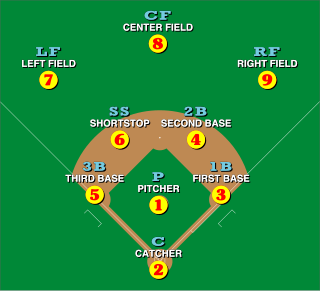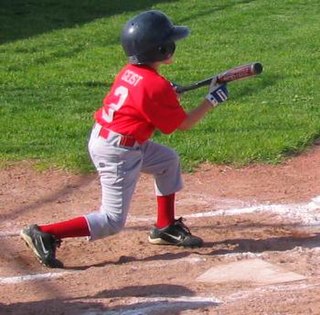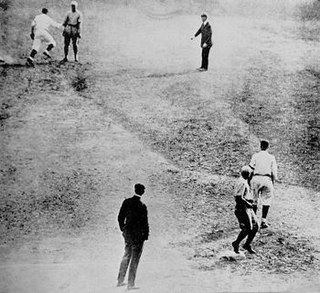
In baseball statistics, a hit, also called a base hit, is credited to a batter when the batter safely reaches first base after hitting the ball into fair territory, without the benefit of an error or a fielder's choice.

Baseball is a bat-and-ball game played between two opposing teams who take turns batting and fielding. Within the game there are positions in which each player can play in.

Softball is a variant of baseball played with a larger ball on a field that has base lengths of 60 feet, a pitcher's mound that ranges from 35-43 feet away from home
plate, and a homerun fence that is 220 feet away from home plate. It was invented in 1887 in Chicago, Illinois, United States as an indoor game. The game moves at a faster pace than traditional baseball. There is less time for the base runner to get to first while the opponent fields the ball; yet, the fielder has less time to field the ball while the opponent is running down to first base. The name softball was given to the game in 1926, because the ball used to be soft, however in modern day usage, the balls are hard.

A bunt is a batting technique in baseball or fastpitch softball. To bunt, the batter loosely holds the bat in front of the plate and intentionally taps the ball into play.
In baseball, a double play is the act of making two outs during the same continuous play. The double play is defined in the Official Rules in the Definitions of Terms, and for the official scorer in Rule 9.11. Double plays can occur any time there is at least one baserunner and less than two outs.

In baseball, an unassisted triple play occurs when a defensive player makes all three outs by himself in one continuous play, without his teammates making any assists. Neal Ball was the first to achieve this in Major League Baseball (MLB) under modern rules, doing so on July 19, 1909. For this rare play to be possible there must be no outs in the inning and at least two runners on base, normally with the runners going on the pitch. An unassisted triple play usually consists of a hard line drive hit directly at an infielder for the first out, with that same fielder then able to double off one of the base runners and tag a second for the second and third outs.
An outfielder is a person playing in one of the three defensive positions in baseball or softball, farthest from the batter. These defenders are the left fielder, the center fielder, and the right fielder. An outfielder's duty is to try to catch long fly balls before they hit the ground or to quickly catch or retrieve and return to the infield any other balls entering the outfield. Outfielders normally play behind the six other members of the defense who play in or near the infield.

The infield fly rule is a rule of baseball that treats certain fly balls as though caught, before the ball is caught, even if the infielder fails to catch it or drops it on purpose. The umpire's declaration of an infield fly means that the batter is out regardless of whether the ball is caught. The rule exists solely to prevent the defense from executing a double play or triple play by deliberately failing to catch a ball that an infielder could catch with ordinary effort.

First base, or 1B, is the first of four stations on a baseball diamond which must be touched in succession by a baserunner to score a run for that player's team. A first baseman is the player on the team playing defense who fields the area nearest first base, and is responsible for the majority of plays made at that base. In the numbering system used to record defensive plays, the first baseman is assigned the number 3.

In baseball, an out occurs when the umpire rules a batter or baserunner out. When three outs are recorded in an inning, a team's half of the inning, or their turn at batting, ends.
The outfield is a sporting term used in cricket and baseball to refer to the area of the field of play further from the batsman or batter than the infield, and in association football to players outside the goal.

The rules of baseball differ slightly from league to league, but in general share the same basic game play.

In baseball and softball, while there are nine named fielding positions, players, with the exception of the pitcher and catcher, may move around freely. The positioning for the other seven positions is very flexible, although they all have regular depths—distances from home plate, and sometimes lateral positioning. A shift means that a player is playing in a noticeably different location than the norm for his positioning. A fielder who is playing shallow or in is playing closer to home plate, while a player playing deep is playing farther from home plate than normal.
In baseball, interference occurs in situations in which a person illegally changes the course of play from what is expected. Interference might be committed by players on the offense, players not currently in the game, catchers, umpires, or spectators. Each type of interference is covered differently by the rules.

In baseball, a batted ball is any ball that, after a pitch, is contacted by the batter's bat. One or more of several terms are used to describe a batted ball, depending on how it comes off the bat and where in the field it lands.
A hit and run is a high risk, high reward offensive strategy used in baseball. It uses a stolen base attempt to try to place the defending infielders out of position for an attempted base hit.

The infield shift is a generic term used in baseball to describe a defensive realignment from the standard positions to blanket one side of the field or another. Used primarily against left-handed batters, it is designed to protect against base hits pulled hard into the gaps between the fielders on one side.
A fifth infielder is the rare instance in baseball when a team may elect to bring in an outfielder to play the infield. This is usually done when the game is tied in the bottom of the ninth or an extra inning, the home team has a runner at 3rd base with fewer than two outs. Normally with a runner on 3rd with less than two outs, a manager will usually have the infield playing in, as to cut down a runner trying to score. Bringing the infield in is a typical strategy used late in games, when a potential tying, go-ahead, winning or crucial insurance run is at 3rd base with less than two outs. In cases like this, if a ball is hit right to an infielder, the infielder usually has a chance to throw out the runner trying to score. However, any ground ball not hit at an infielder will usually have a good chance to score the runner, plus the batter reaching base safely, versus if the infield plays back. When the infield plays back, it does make it more likely for the run to score, but the infielders are more likely to get the batter out via. a ground out.













